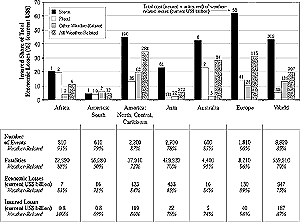8.3.3.1. Quantifying Vulnerability and Adaptive Capacity
|

Figure 8-6:Regional insurance coverage for weather- and non-weather-related
natural disasters, 1985-1999. The role of insurance in paying weather-related
losses varies by event type and region, generally dominated by windstorm
(Munich Re, 1999b). "Other" includes weather-related events
such as wildfire, landslides, land subsidence,avalanches, extreme temperature
events, droughts, lightning, frost, and ice/snow damages (Munich Re, 2000).
The numbers generally include "captive" self-insurers but not
the less-formal types of self-insurance. Total costs are higher than those
summarized in Figure 8-1 because of the restriction ofFigure 8-1 losses
to those from large catastrophic events. Rounding errors may appear in
data labels.
|
For insurers, vulnerability can be viewed broadly in terms
of the sector's capacity to pay for extreme events, together with the temporal
sequence of such events. The key to vulnerability is the probable maximum loss
(PML), which is the best estimate of the cost that is likely to emanate from
an event with a specified probability of occurrence. In recent times, PMLs often
have been revised upward significantly. The European winter storms Lothar and
Martin of 1999 (US$8.4 billion insured losses) caught European insurers and
reinsurers offguard, presenting losses that substantially exceeded prevailing
expectations. These storms constituted the most serious natural disaster ever
covered by insurance in France, with about 3 million claims (FFSA, 2000). One
recent estimate for the United States was a combined PML of US$155 billion for
1-in-100-year (i.e., 1% yr-1 likelihood) for all types of natural disasters
nationally (see Figure 15-8).
Unnewehr (1999) segmented the market and estimated that 17% of 1997 U.S. P/C
insurance premiums were associated with "significant" exposure to
weather-related loss. The paper did not explore other measures or sources of
vulnerability and exposure, such as total insured property values at risk (US$4
trillion in insured property in the Gulf and Atlantic coastal counties of the
United States) (Hooke, 2000), or the extent of insolvency risk. These results
are not transferable to other regions, where insurance systems and natural hazards
can be very unlike those in the United States (see Figure 8-6).
The particular role of weather in vehicle-related losses is not well studied.
Vehicle insurance represents 48% of U.S. P/C premiums; it is ranked in the aforementioned
study as having "minor" weather sensitivity. Of total vehicle-related
accidents, 16% of those in the United States are caused by adverse weather conditions
(NHTSA, 1999); 33% of those in Canada are weather related (White and Etkin,
1997). Physical damage to vehicles during U.S. natural catastrophes between
1996 and mid-2000 represented an additional $3.4 billion (10%) of total insured
property losses, ranging as high as 55% for individual events (PCS, 2000; Mills
et al., 2001).
Although aggregate industry assessments are useful, analyses of vulnerability
clearly must take into account the complexity and specialized structure of the
insurance sector (GAO, 2000a). Although an aggregate U.S. insurance surplus
of US$200-350 billion often is cited (Doherty, 1997; GAO, 2000a), roughly
80% of this surplus is required for non-weather-sensitive branches (e.g., workers'
compensation), assuming proportionality with premium-based risk figures quoted
by Unnewehr (1999). In addition, insurers are independent and have radically
different mixes of risks, so individual firms may become insolvent long before
losses approach the industry's aggregate capacity (Doherty, 1997; Klein,
1997). Single-state PML events at the 1% likelihood level would result in economic
stress ranging from 5 to 60% of insurers by market share (Pullen, 1999b). Moreover,
catastrophes can disrupt insurance markets and harm insurance companies and
consumers even in cases in which all claims are paid (GAO, 2000a; Ryland, 2000).
Reinsurance adequacy is another issue in vulnerability assessment. Swiss Re
(1997) concluded that the availability of reinsurance coverage for natural disasters
in 14 major markets was insufficient and that following a major event, primary
insurers' (the customers of reinsurers) equity base (surplus) would come
under considerable strain. For PML windstorm events in Australia, Japan, and
the United States, the impact on aggregate surplus would be reductions of 24,
41, and 11%, respectively (Swiss Re, 1997). Solvency analyses typically give
only "partial credit" to primary insurers for reinsurance (e.g., 50%
in the European Union) because of the uncertain viability of reinsurance contracts
or reinsurers themselves following catastrophic losses (Doherty et al.,
1992; Swiss Re, 2000a).
Aside from issues of solvency, past extreme weather events clearly have measurable
short- to medium-term impacts on insurance and reinsurance profitability—even
at a national scale (Figure 8-4a) and on the availability
of insurance following the event (Davidson 1996; Pullen, 1999b). Catastrophe
losses during 1999 and 2000 contributed to marked short-term depressions in
earnings and stock prices for several large insurers and reinsurers (Edgecliffe-Johnson,
1999; Carpenter, 2000; Lonkevich, 2000). This development can restrict insurers'
ability to raise new capital for expansion or even to continue the operations
of highly exposed branches.
The overarching insurance business environment also is a key factor in determining
vulnerability. Cyclical pressures or incidental broad-based stresses on the
industry—such as major tobacco litigation (Bradford, 2000; Clow, 2000;
Hofmann, 2000a), the crisis in environmental liability insurance (U.S. Superfund,
asbestos, and lead paint claims), the Asian financial crisis, or increased competition
from Internet sales (Ceniceros, 2000)—could place considerable demands
on surplus (Mooney, 1999; GAO, 2000a; Swiss Re, 1998b, 2000a). Developments
in financial markets can influence the level and availability of insurance surplus
(Cummins et al., 1999; GAO, 2000b; Swiss Re, 2000a). More than three-quarters
of the growth in the U.S. insurance industry's surplus since 1995 resulted
from capital gains (GAO, 2000a).
On one hand, the trend toward convergence between banking and insurance potentially
increases diversification and robustness. On the other hand, it exposes one
sector to risks faced in the other, and, in some cases, geographical diversification
of a company's insurance business has moved it into the path of increased
disaster losses (Berry, 2000; Greenwald, 2000; Howard, 2000b; Lonkevich, 2000).
Weather-related vulnerability could increase if insurers participate in emerging
capital market alternatives for risk financing (Marcon, 1999). In general, such
convergence is more likely for the life insurance segment
|